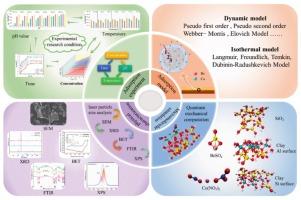土壤对Be2+和Cu2+的固定化:俘获行为、定量模型和量子机制
IF 5.2
2区 化学
Q2 CHEMISTRY, PHYSICAL
引用次数: 0
摘要
铍铜合金加工过程中产生的Be2+和Cu2+离子具有较高的毒性,具有较大的环境污染风险。土壤对Be2+的固定化是了解其污染的重要环节,也是铍污染后土壤修复的核心步骤。然而,对土壤对Be2+的固定化作用,特别是土壤质地的影响、定量吸附过程和微观相互作用机制的了解还不够。本研究通过批量吸附实验、数学模型、材料表征和量子力学计算等方法系统揭示了Be2+和Cu2+离子在不同质地土壤中的宏观和微观行为及其机制,并建立了解决这些空白的定量多尺度框架。主要发现包括Be2+的快速吸附(16小时内约30 mg/kg),不同的ph依赖模式和放热反应。吸附动力学遵循伪二阶模型(R2 > 0.99),而等温线(Freundlich, Temkin, D-R)证实了化学吸附在非均质表面上的优势。表征技术表明,粘土具有较大的比表面积和活性位点(SiO, AlO),有利于通过化学键固定。量子计算进一步证实了高岭石的al端表面对Be2+的优越吸附活性。这可以从更短的BeO键长(1.589 Å)和更大的吸附能中得到证明,这合理地解释了实验中观察到的Be2+较高的固定化强度。这项工作为土壤中Be2+固定的多尺度机制提供了深刻的见解。本文章由计算机程序翻译,如有差异,请以英文原文为准。

Immobilization of Be2+ and Cu2+ by soils: Trapping behavior, quantitative model and quantum mechanism
Be2+ and Cu2+ ions from beryllium copper alloy processing pose significant environmental pollution risks due to their high toxicity. The immobilization of Be2+ by soil is an important link in understanding its pollution and also a core step in soil remediation after beryllium pollution. However, understanding the immobilization of Be2+ by soil is insufficient, particularly regarding the influence of soil texture, quantitative adsorption processes, and microscopic interaction mechanisms. This study systematically reveals the macroscopic and microscopic behaviors and mechanisms of Be2+ and Cu2+ ions in soils of different textures through batch adsorption experiments, mathematical models, material characterization, and quantum mechanical calculations It establishes a quantitative multi-scale framework addressing these gaps. Key findings include rapid Be2+ adsorption (about 30 mg/kg within 16 h), distinct pH-dependent patterns, and exothermic reactions. Adsorption kinetics followed the pseudo-second-order model (R2 > 0.99), while isotherms (Freundlich, Temkin, D-R) confirmed chemisorption dominance on heterogeneous surfaces. Characterization techniques revealed that clayey soils, with larger specific surface areas and active sites (Si![]() O, Al
O, Al![]() O), facilitate immobilization via chemical bonding. Quantum calculations further confirmed the superior adsorption activity of kaolinite's Al-terminated surface for Be2+. This can be evidenced by the shorter Be
O), facilitate immobilization via chemical bonding. Quantum calculations further confirmed the superior adsorption activity of kaolinite's Al-terminated surface for Be2+. This can be evidenced by the shorter Be![]() O bond length (1.589 Å) and larger adsorption energy, rationalizes the higher immobilization strength of Be2+ observed in experiments. This work provides profound insights into the multi-scale mechanisms of Be2+ immobilization in soils.
O bond length (1.589 Å) and larger adsorption energy, rationalizes the higher immobilization strength of Be2+ observed in experiments. This work provides profound insights into the multi-scale mechanisms of Be2+ immobilization in soils.
求助全文
通过发布文献求助,成功后即可免费获取论文全文。
去求助
来源期刊

Journal of Molecular Liquids
化学-物理:原子、分子和化学物理
CiteScore
10.30
自引率
16.70%
发文量
2597
审稿时长
78 days
期刊介绍:
The journal includes papers in the following areas:
– Simple organic liquids and mixtures
– Ionic liquids
– Surfactant solutions (including micelles and vesicles) and liquid interfaces
– Colloidal solutions and nanoparticles
– Thermotropic and lyotropic liquid crystals
– Ferrofluids
– Water, aqueous solutions and other hydrogen-bonded liquids
– Lubricants, polymer solutions and melts
– Molten metals and salts
– Phase transitions and critical phenomena in liquids and confined fluids
– Self assembly in complex liquids.– Biomolecules in solution
The emphasis is on the molecular (or microscopic) understanding of particular liquids or liquid systems, especially concerning structure, dynamics and intermolecular forces. The experimental techniques used may include:
– Conventional spectroscopy (mid-IR and far-IR, Raman, NMR, etc.)
– Non-linear optics and time resolved spectroscopy (psec, fsec, asec, ISRS, etc.)
– Light scattering (Rayleigh, Brillouin, PCS, etc.)
– Dielectric relaxation
– X-ray and neutron scattering and diffraction.
Experimental studies, computer simulations (MD or MC) and analytical theory will be considered for publication; papers just reporting experimental results that do not contribute to the understanding of the fundamentals of molecular and ionic liquids will not be accepted. Only papers of a non-routine nature and advancing the field will be considered for publication.
 求助内容:
求助内容: 应助结果提醒方式:
应助结果提醒方式:


